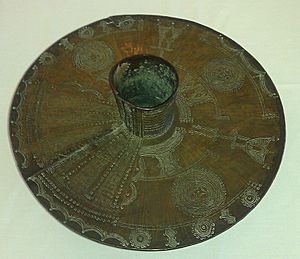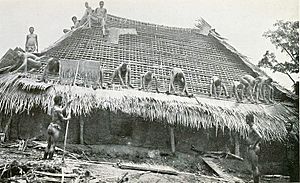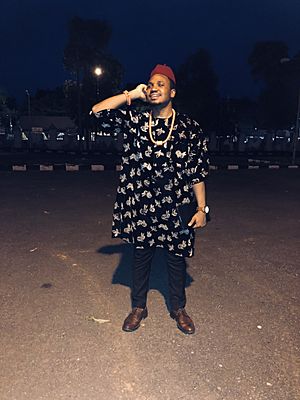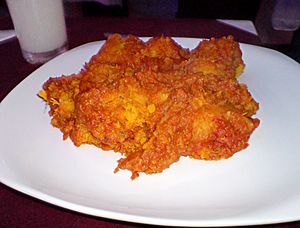Igbo people facts for kids
| Ṇ́dị́ Ìgbò | |
|---|---|
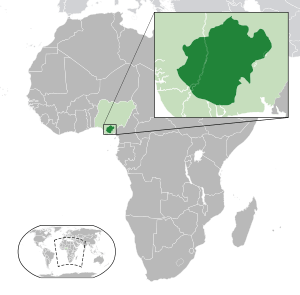
Location of the Igbo homeland (dark green)
in Nigeria (green) |
|
| Total population | |
| c. 45 million (2020 est.) | |
| Regions with significant populations | |
| Languages | |
| Religion | |
| Primarily Christianity, sometimes syncretised with indigenous Igbo religion and belief systems, | |
| Related ethnic groups | |
| Ibibio, Efik, Annang, Bahumono, Ogoni, Idoma, Igala, Urhobo, Ijaw, Ogoja, Krio; more remotely the YEAI group within Volta-Niger |
The Igbo people are a large group of people who originally come from south-central and southeastern Nigeria. They also live in Equatorial Guinea. People wonder where the Igbo people first came from. Their homeland, called Igboland, is split into two parts by the Niger River. The Igbo are one of the biggest ethnic groups in Africa.
The Igbo language is part of the Niger-Congo language family. It has many different ways of speaking, called dialects. These dialects are quite similar to each other. The Igbo homeland is near the lower Niger River.
In rural Nigeria, many Igbo people work as craftsmen, farmers, and traders. The most important crop they grow is the yam. Other main foods include cassava and taro.
Before the British ruled in the 1900s, the Igbo lived in many small groups. They did not have one big kingdom. Some of their early kingdoms were Nri, Aro Confederacy, Agbor, and Onitsha. The British ruler, Frederick Lugard, introduced a new system of chiefs. The Igbo were not affected by a war that spread Islam in Nigeria in the 1800s. They became mostly Christian when the British ruled.
After countries started to become independent, the Igbo people felt very proud of being Igbo. During the Nigerian Civil War from 1967 to 1970, the Igbo areas tried to form their own country called Republic of Biafra. But it only lasted a short time. A group called MASSOB, started in 1999, is still working peacefully for an independent Igbo state.
Many Igbo people also live in Cameroon, Gabon, and Equatorial Guinea. You can also find Igbo communities outside of Africa.
Contents
Igbo Culture and Traditions
Igbo culture includes many different customs and traditions. Some are very old, while others have changed over time. This includes their art, language, music, dance, clothes, and food. Because there are many different Igbo subgroups, their culture is even more varied.
Language and Stories

The Igbo language is written using the Roman alphabet. It also used to be written with Nsibidi symbols. These symbols were used by secret societies, so they became a secret way of communicating. Nsibidi symbols were used by the Igbo before the 1500s.
Igbo is a tonal language. This means the meaning of a word can change depending on the pitch of your voice. There are hundreds of different Igbo dialects. Some are so different they are considered separate languages, like Ikwerre and Ekpeye. In 1939, a researcher named Dr. Ida C. Ward studied Igbo dialects. She helped create a standard Igbo dialect, called Central Igbo. This dialect was accepted by writers and universities.
In 1789, a book called The Interesting Narrative of the Life of Olaudah Equiano was published. It was written by Olaudah Equiano, a former slave. This book included 79 Igbo words. It also described many parts of Igbo life based on Equiano's childhood. Before this book, a German missionary named C. G. A. Oldendorp published some Igbo words in 1777.
One of the most famous novels about the Igbo is Things Fall Apart by Chinua Achebe, published in 1959. The book shows how British rule and Christian missionaries affected a traditional Igbo community. Most of the story takes place in Iguedo, a village near the Niger River.
Music and Dance
The Igbo people have a special musical style. They use many percussion instruments. These include the udu, which is a clay pot, and the ekwe, made from a hollow log. They also use the ogene, a hand bell made of iron. Other instruments are the opi (like a flute), igba, and ichaka.
Highlife is another popular music style among the Igbo. It mixes jazz with traditional music. Famous Igbo highlife musicians from the 1900s include Dr Sir Warrior, Oliver De Coque, Bright Chimezie, and Chief Osita Osadebe.
Masking is a very common art form in Igboland. It is closely linked to Igbo traditional music. Masks can be made from wood or fabric. They are used for plays, religious events, secret society meetings, and public festivals. Some well-known masks are the Agbogho Mmuo (Maiden spirit) masks. These masks represent the spirits of young women and their mothers. They symbolize beauty.
Other impressive masks are the Northern Igbo Ijele masks. These masks are very tall, about 12 feet high. They have platforms that are 6 feet wide. They show scenes from everyday life using colorful cloth. Ijele masks are used to honor the dead. They are only seen on special occasions, like when an important person dies.
There are many Igbo dance styles. The Atilogwu dance is very famous. Dancers perform acrobatic moves like high kicks and cartwheels. Each beat from the instruments tells the dancer what movement to make. The Egedege Dance is a royal-style traditional dance. It is one of the most famous dances in southeastern Nigeria.
Art and Buildings
There are many different Igbo groups, so there isn't one single Igbo art style. Igbo art is known for its many types of masquerade masks and outfits. These can look like people, animals, or abstract shapes.
The oldest sculptures found in Igboland are bronze castings from the town of Igbo Ukwu. These date back to the 800s. In Igbo Ukwu, a rich man's grave and a special store were found. They contained copper objects and detailed bronze castings. Along with these, there were 165,000 glass beads from Egypt, Venice, and India. A popular Igbo art style is Uli designs. Most Igbo groups carve and use masks, but their purpose varies.
Igbo art is also known for Mbari architecture.
Mbari houses are large, open-sided shelters built by the Owerri-Igbo. They hold many life-sized, painted figures made of mud. These figures are made to please the Alusi (deities) and Ala, the earth goddess. Other figures include officials, craftsmen, foreigners, animals, and ancestors. Mbari houses take years to build. When new ones are built, the old ones are left to slowly fall apart.
Everyday houses were made of mud. They had thatched roofs and dirt floors. Some houses had beautiful designs inside and out. These designs were often Uli art created by Igbo women.
One special structure in Igbo culture was the Nsude Pyramids. These were in the town of Nsude. Ten pyramid-shaped structures were built from clay or mud. The bottom part was about 60 feet around and 3 feet high. The next part was 45 feet around. The circular parts continued up to the top. These structures were temples for the god Ala/Uto. A stick was placed at the top to show where the god lived. The pyramids were built in groups of five, next to each other. Because they were made of clay, they needed to be rebuilt regularly.
Religion and Life Stages

Most Igbo people are Christian.
Christianity came to the Igbo people when Europeans started to rule in 1857. At first, the Igbo were careful about becoming Christian. They worried their traditional gods would bring bad luck. But over time, more Igbo people became Christian. This happened mostly because church workers built schools and taught young people Christian values. Today, the Igbo people are known for adopting Christianity more than any other ethnic group in Africa.
The Igbo people were not affected by the Islamic holy war in Nigeria in the 1800s. However, a small number of Igbo people became Muslim in the 1900s.
There is also a small group of Igbo Jews. Some identify as Jews, while others have converted to Judaism. They are inspired by Olaudah Equiano. He was a freed slave who wrote in his book in 1789 that the Igbo people had many customs similar to the Jews. This idea has led to much discussion about where the Igbo people originally came from.
Traditional Religion
The traditional Igbo religion is called Odinani. The highest god is called Chukwu ("great spirit"). Chukwu created the world and everything in it. The Igbo believe that everything on Earth, in heaven, and in the spirit world is controlled by Chukwu. The name Chukwu comes from two Igbo words: Chi (spiritual being) and Ukwu (great).
Each person is born with a spiritual guide or guardian angel called "Chi." This Chi is unique to each person and helps decide their fate. The Igbo say that even if siblings come from the same mother, they have different Chis and different destinies. Alusi, also called Arusi, are smaller gods that are worshiped in Odinani. There are many different Alusi, each with its own purpose. If a god is no longer needed or becomes too harmful, it can be left behind.
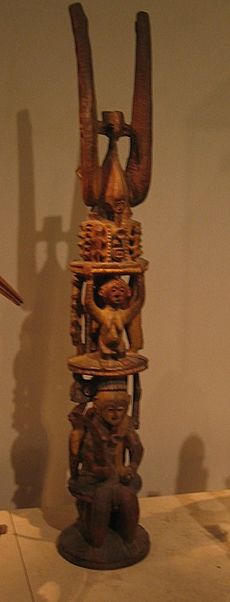
The Igbo have traditionally believed in reincarnation. They believe people are reborn into families they were part of when they were alive. Before someone dies, they might give hints about who they will be reborn as in the family. Once a child is born, they are believed to show signs of who they have reincarnated from. This can be seen in their behavior, looks, or what they say. A special person can help find out who the child has reincarnated from. It is considered an insult if a boy is said to have been reborn as a girl.
Children are not allowed to call elders by their first names without using a special title. This is seen as disrespectful. To show respect, children must greet elders when they see them for the first time each day. Children usually add the Igbo titles Mazi or Dede before an elder's name.
Burials
After a person dies, the body of an important community member is placed on a stool in a sitting position. They are dressed in their best clothes. Sometimes, animals are sacrificed. The dead person is also given perfume. Burial usually happens within 24 hours. Today, the head of a family is often buried inside their home compound.
Different types of deaths mean different types of burials. This depends on the person's age, gender, and importance in society. Children are buried secretly, usually in the early morning or late at night. A simple man is buried in front of his house. A simple mother is buried where she was born, in a garden or farm that belonged to her father. In the 2000s, most Igbo people bury their dead in the Western style. However, traditional Igbo burials are still common.
Marriage
The process of getting married usually involves several steps. First, the young woman's agreement is asked. Then, the woman is introduced to the man's family, and the man to the woman's family. The bride's character and family background are checked. Finally, the bride's wealth is paid. This payment is usually more symbolic. It can include kola nuts, wine, goats, and chickens. Negotiating the bride wealth can take more than one day. This allows time for a special feast.
Sometimes, marriages were arranged from birth by the two families. However, a study in the 1990s found that most Igbo women (94.4%) did not approve of arranged marriages.
Men sometimes married more than one wife. This was often for economic reasons. Having more people in the family, including children, helped with farm work. Christian and civil marriages have changed Igbo family life since colonial times. Some Western wedding customs, like church weddings, happen either before or after the traditional Igbo marriage.
Clothing
Traditionally, the Igbo wore very little clothing. The main purpose of clothes was to cover private parts. Uli body art was used to decorate both men and women. It involved lines forming patterns and shapes on the body.
Women traditionally carry their babies on their backs using a strip of cloth. This cloth binds the baby to the mother, with a knot at her chest. This practice is common in many parts of Africa. Today, this method has been updated with modern child carriers. Young women usually wore a short wrapper with beads around their waist. They also wore other jewelry like necklaces. Both men and women wore wrappers. Men wore loin cloths that wrapped around their waist and between their legs. This type of clothing was good for the hot weather and for jobs like farming.
In Olaudah Equiano's story, he describes perfumes used by the Igbo in his community:
Our principal luxury is in perfumes; one sort of these is an odoriferous wood of delicious fragrance: the other a kind of earth; a small portion of which thrown into the fire diffuses a most powerful odor. We beat this wood into powder, and mix it with palm oil; with which both men and women perfume themselves.
As British rule became stronger, the Igbo changed their clothing customs. The clothes worn before became "traditional" and are now worn for cultural events. Modern Igbo traditional clothing for men is usually the Isiagu top. This top looks like the Dashiki worn by other African groups. Isiagu (or Ishi agu) often has lion heads embroidered on it. It can be a plain color. It is worn with trousers and can be paired with a special hat for title holders or a striped men's hat called Okpu Agu. For women, a puffed sleeve blouse is worn with two wrappers and a head tie.
Food
The yam is very important to the Igbo people. It is their main food crop. Yams can stay good for six months without a fridge. They can also be used in many different dishes. Yams can be fried, roasted, boiled, or made into a stew with tomatoes and herbs. Men usually grow yams, while women focus on other crops.
There are celebrations like the New Yam festival (Igbo: Iwaji). This festival celebrates the yam harvest. During the festival, yam is eaten throughout the communities. People show off their yam tubers as a sign of success and wealth. For many special occasions, rice has replaced yam. Other local foods include cassava, garri, maize, and plantains.
Soups or stews are often part of a meal. They are made with vegetables like okra (the word okra comes from the Igbo word Okwuru). Pieces of fish, chicken, beef, or goat meat are added to the soups. Jollof rice is popular across West Africa. Palm wine is a popular traditional alcoholic drink.
Images for kids
-
Bronze from the 800s, found in Igbo Ukwu, now in the British Museum.
-
An Igbo man with facial scarifications, called ichi, early 1900s.
-
A wooden sculpture of Ikenga, an Alusi, in the Musée du Quai Branly.
-
Igbo people celebrating the New Yam festival in Dublin, Ireland.
See also
 In Spanish: Pueblo igbo para niños
In Spanish: Pueblo igbo para niños


